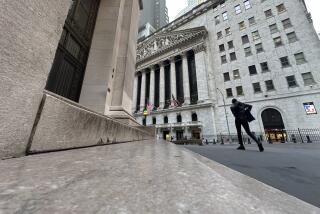Stocks finish with modest losses
Wall Street clawed its way back from an early plunge to finish with modest losses Thursday, after some upbeat data on the manufacturing sector allayed fears about a flagging U.S. economy.
But many analysts said it was far from certain that the battered market was bottoming out.
Sharp drops such as the one on Tuesday are rarely followed by immediate recoveries, in part because investors’ confidence in the market gets shaken and must be reestablished.
“Once you put one of these things in motion you don’t just turn it on a dime and it’s over,” said Jim Paulsen, chief investment strategist at Wells Capital Management.
The Dow Jones industrial average plummeted 209 points at the opening of the trading session, spooked by renewed fears about the global economy.
The market began to recover after the Institute for Supply Management’s index of U.S. manufacturing activity in February came in at 52.3, stronger than the 50 reading analysts expected.
A reading at 50 and above indicates expansion, while anything below 50 signals contraction.
Stocks quickly rebounded, then traded in a narrow range the rest of the day.
The Dow ended with a loss of 34.29 points, or 0.3%, at 12,234.34.
The Standard & Poor’s 500 index eased 3.65 points, or 0.3%, to 1,403.17.
The Nasdaq composite was off 11.94 points, or 0.5%, to 2,404.21.
Despite the small losses, losers topped winners by more than 3 to 2 on the New York Stock Exchange and by 2 to 1 on Nasdaq. Trading remained very heavy.
Investors are now trying to determine which of two economic scenarios to believe: The one that held until last week, which is that the global economy is strong overall. Or the one that has cropped up this week, which posits that weakness in the U.S. manufacturing, housing and auto sectors will slowly spill into other sectors, putting the economy at risk of recession.
The Dow sank 416 points, or 3.3% on Tuesday, its worst drop in four years, amid a broad global sell-off tied to economic jitters.
Also fueling Tuesday’s drop was an 8.8% slide in the Shanghai stock market, on rumors that the Chinese government wanted to rein in that highflying market.
The U.S. market rebounded somewhat Wednesday after Federal Reserve Chairman Ben S. Bernanke said he was optimistic about economic growth.
Still, “The early morning hours [Thursday] raised the concern that we haven’t hit our bottom yet,” said Jack Caffrey, equities strategist at J.P. Morgan Private Bank. “It’s probably going to be a grinding, sideways movement over the next few days as people realize there are risks out there.”
The Japanese stock market fell for a third straight day Thursday, with the Nikkei-225 index off 150.61 points, or 0.9%, to 17,453.51.
Most European markets also ended lower. The German market fell 1.1%. British stocks were off 0.9%.
The Shanghai market fell 2.9% after gaining 3.9% on Wednesday.
Besides their concerns about the economy, some investors are nervous that a popular strategy of recent years -- borrowing at rock-bottom interest rates in Japan to invest in securities elsewhere on the globe -- is going awry, causing investors to dump whatever they bought.
One issue is that Japanese interest rates are rising. Another is that the yen is strengthening in value, which can mean losses for investors who borrowed in yen to buy securities denominated in other currencies.
The dollar ended at 117.58 in New York on Thursday, down from 118.12 on Wednesday and 121.58 a week earlier.
Investors’ sudden aversion to risk helped to boost Treasury bond prices, pushing yields lower. The 10-year T-note ended 4.55%, down from 4.57% on Wednesday.
But gold, which normally benefits from market turmoil, pulled back. Near-term gold futures in New York fell $7.10 to $662.30 an ounce.
A steady rise in oil prices is giving investors something else to worry about. Near-term crude futures rose 21 cents to $62 a barrel, the highest since Dec. 22.
Among the day’s market highlights:
* Buyers continued to favor stocks of companies whose sales tend to hold up well in a weak economy. Procter & Gamble added 19 cents to $63.68, drug firm Pfizer gained 8 cents to $25.04, and Playtex Products was up 36 cents to $14.02.
* Shares of sub-prime mortgage lenders were mixed. Pasadena-based IndyMac Bancorp slumped $2.17 to $32.16 after saying this year’s profit would be lower than in 2006. Also in the sector, Countrywide Financial fell 90 cents to $37.44. But Fremont General gained 29 cents to $9.10.
* Some industrial issues remained weak on economic fears. U.S. Steel lost 95 cents to $87.73, and Toyota Motor fell $2.32 to $131.28.
* Apple jumped $2.45 to $87.06 after positive comments from brokerages Morgan Stanley and Lehman Bros.
* Biotech giant Amgen fell $2.56 to $61.70 amid safety concerns about its anemia drug Aranesp.
More to Read
Inside the business of entertainment
The Wide Shot brings you news, analysis and insights on everything from streaming wars to production — and what it all means for the future.
You may occasionally receive promotional content from the Los Angeles Times.










